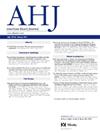先天性心脏病患者因流感感染住院后发生心血管事件的风险--一项基于全国人口的研究。
IF 3.7
2区 医学
Q1 CARDIAC & CARDIOVASCULAR SYSTEMS
引用次数: 0
摘要
背景:病毒感染导致的心血管并发症对先天性心脏病(CHD)患者等易感人群构成重大风险。有关流感发病率及其对这一特殊患者群体心血管后果影响的数据有限:我们利用加拿大先天性心脏病(CanCHD)数据库设计了一项回顾性队列研究,该数据库是一个泛加拿大先天性心脏病患者数据库,随访时间长达 35 年。研究人员对 2010 年至 2017 年期间因流感病毒住院的 40 岁至 65 岁先天性心脏病患者进行了鉴定,并根据年龄和日历时间与因肢体骨折住院的先天性心脏病患者进行了 1:1 匹配。我们的主要终点是心血管并发症:心力衰竭、急性心肌梗死、房性心律失常、室性心律失常、心脏传导阻滞、心肌炎和心包炎:在 303 例流感病毒相关住院患者中,有 255 例与 255 例肢体骨折住院患者相匹配。与骨折住院患者相比,流感病毒相关住院患者在一年(0.16 对 0.03)和五年(0.33 对 0.15)后出现心血管并发症的累积概率明显更高。时间依赖性危险函数模型显示,与流感相关的住院患者在出院后九个月内出现心血管并发症的风险明显更高。Cox回归模型证实了这一关联(整个随访期间的平均危险比:2.48;95% CI:1.59 - 3.84):这项针对患有冠心病的成年人的泛加拿大队列研究表明,流感病毒相关住院治疗与出院后九个月内心血管并发症风险之间存在关联。这些数据对于规划监测策略以减轻不良后果至关重要,并为解读 COVID-19 等其他新病原体的并发症发生率提供了启示。本文章由计算机程序翻译,如有差异,请以英文原文为准。
Risk of cardiovascular events after influenza infection-related hospitalizations in adults with congenital heart disease: A nationwide population based study
Background
Cardiovascular complications due to viral infection pose a significant risk in vulnerable patients such as those with congenital heart disease (CHD). Limited data exists regarding the incidence of influenza and its impact on cardiovascular outcomes among this specific patient population.
Methods
A retrospective cohort study was designed using the Canadian Congenital Heart Disease (CanCHD) database—a pan-Canadian database of CHD patients with up to 35 years of follow-up. CHD patients aged 40 to 65 years with influenza virus-associated hospitalizations between 2010 and 2017 were identified and 1:1 matched with CHD patients with limb fracture hospitalizations on age and calendar time. Our primary endpoint was cardiovascular complications: heart failure, acute myocardial infarction, atrial arrhythmia, ventricular arrhythmia, heart block, myocarditis, and pericarditis.
Results
Of the 303 patients identified with incident influenza virus-associated hospitalizations, 255 were matched to 255 patients with limb fracture hospitalizations. Patients with influenza virus-related hospitalizations showed significantly higher cumulative probability of cardiovascular complications at 1 year (0.16 vs. 0.03) and 5 years (0.33 vs. 0.15) compared to patients hospitalized with bone fracture. Time-dependent hazard function modeling demonstrated a significantly higher risk of cardiovascular complications within 9 months postdischarge for influenza-related hospitalizations. This association was confirmed by Cox regression model (average hazard ratio throughout follow-up: 2.48; 95% CI: 1.59-3.84).
Conclusions
This pan-Canadian cohort study of adults with CHD demonstrated an association between influenza virus-related hospitalization and risk of cardiovascular complications during the 9 months post discharge. This data is essential in planning surveillance strategies to mitigate adverse outcomes and provides insights into interpreting complication rates of other emerging pathogens, such as COVID-19.
求助全文
通过发布文献求助,成功后即可免费获取论文全文。
去求助
来源期刊

American heart journal
医学-心血管系统
CiteScore
8.20
自引率
2.10%
发文量
214
审稿时长
38 days
期刊介绍:
The American Heart Journal will consider for publication suitable articles on topics pertaining to the broad discipline of cardiovascular disease. Our goal is to provide the reader primary investigation, scholarly review, and opinion concerning the practice of cardiovascular medicine. We especially encourage submission of 3 types of reports that are not frequently seen in cardiovascular journals: negative clinical studies, reports on study designs, and studies involving the organization of medical care. The Journal does not accept individual case reports or original articles involving bench laboratory or animal research.
 求助内容:
求助内容: 应助结果提醒方式:
应助结果提醒方式:


